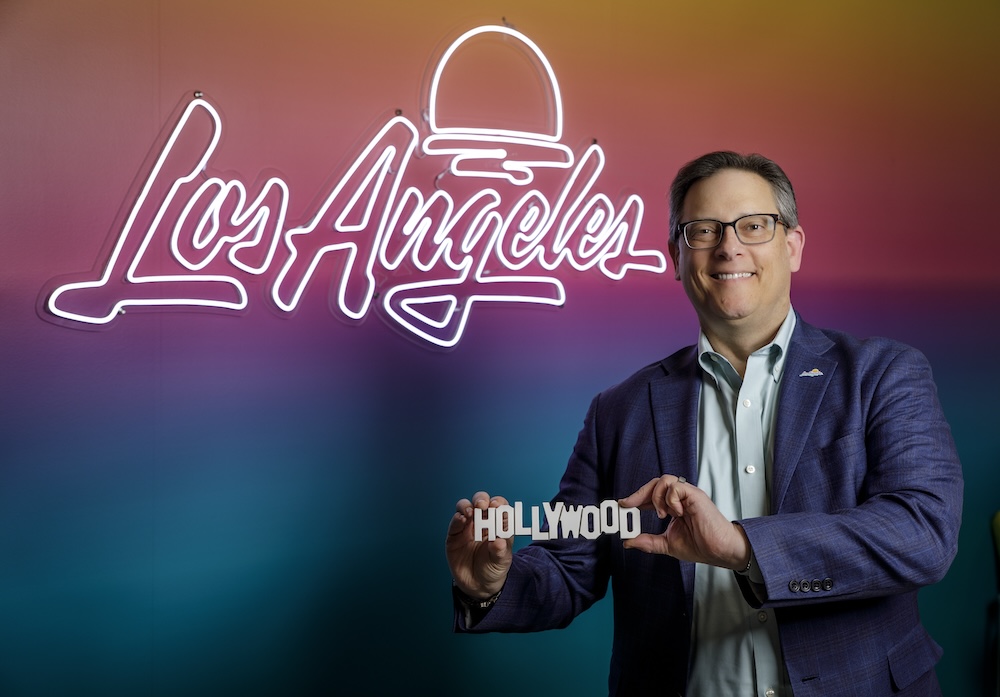
Tourism is important to Los Angeles, but it is an industry that still has not recovered fully from the pandemic.
What’s more, Los Angeles faces challenges in luring tourists. News footage showing large homeless encampments and gangs of smash-and-grab retail looters may deter family travelers. The expected expansion of the city’s convention facilities is stymied, meaning the city isn’t attracting as many conventioneers as hoped.
And some believe the number of business travelers may be permanently lower.
The Business Journal wanted to get the perspective of Adam Burke, who, as president and chief executive of the Los Angeles Tourism and Convention Board, is charged with keeping Los Angeles as a destination for tourists. In this interview, Burke said the troubling images coming out of Los Angeles are less of a concern because they’re viewed not as an L.A.-specific issue but more of a nationwide urban one. However, he said he is “deeply concerned” about the lack of progress with the convention center expansion.
What new initiatives has L.A. Tourism launched to boost tourism to Los Angeles – both internationally and domestically?
As context, it will take another 24 to 36 months before tourism fully recovers in Los Angeles. While domestic leisure travel has rebounded quickly, the convention and international segments will take longer to match pre-pandemic levels. Overseas visitors are particularly critical since they spend two to three times more than domestic guests. To accelerate recovery, we’ve launched the next phase of our award-winning ‘Now Playing’ promotional campaign in key international and domestic markets, highlighting that – remarkably – there are even more reasons to visit our City of Angels than before the pandemic. The previous campaign drove $3 billion in incremental sales to our local business community.

On tourist travel to Los Angeles, international travel has rebounded sharply over the past year at Los Angeles International Airport, while the growth in domestic travel has been much slower. What do you think accounts for the tapering off of domestic travel to Los Angeles and what can be done about it?
It’s important to recognize that visitors to Los Angeles arrive by land, sea and air. Taking that holistic perspective, domestic travel has actually returned to pre-pandemic levels. And, despite concerns about an economic downturn, industry analysts report that in a post-pandemic environment, people are prioritizing travel above virtually all other discretionary spending categories. To capitalize on this trend, we’re using the umbrella message of “L.A. 2.0” to clearly help consumers, media, and the travel trade understand that if you haven’t been to Los Angeles since 2019, you haven’t really been to L.A.!
These days, headlines from Los Angeles are often dominated by images of the homeless and of crime, especially retail theft. How much of an impact do you think these images and headlines are having on the willingness of people to travel here from other states or from other countries?
First and foremost, we’re grateful for the urgency and pragmatism with which Mayor Karen Bass and her administration are addressing the needs of unhoused Angelenos while still supporting L.A.’s economic recovery. Through close collaboration with Doane Liu, the executive director of the L.A. Tourism Department, there’s been a heightened focus on safety and security to ensure that visitors have a safe and memorable experience. Thankfully, research shows that these are broader perceptions of all urban destinations and not as an L.A.-specific issue. And while it does come up as a concern among prospective visitors, it isn’t having a material impact on travel demand.
Plans to expand the Los Angeles Convention Center have long been stalled at L.A. City Hall. How concerned are you that the Convention Center expansion won’t be completed before the 2028 Summer Olympic and Paralympic Games? What do you think is needed to break the logjam at City Hall?
I am deeply concerned by the urgent need to move forward with the expansion, since major conventions generated $8 billion for local businesses in 2019 alone. Currently, 90% of the top 250 conventions meet in just 20 destinations and Los Angeles isn’t among them. Since our center can’t accommodate events requiring over 350,000 square feet of contiguous meeting space, we’re tied for 22nd place in the nation with Kansas City, Missouri. These conventions are booked 5-10 years in advance, so we are already losing business to other destinations, with $2.4 billion in incremental bookings at stake between now and 2030.
Speaking of conventions, how has the pandemic altered the landscape for conventions? The common perception is that not as many businesses see the need to attend conventions these days. What’s your take on this?
This is actually a common misperception. In fact, individual corporate business travel is taking longer to recover, with many organizations finding it more cost-effective to have their teams attend conferences and tradeshows where a significant amount of business can be accomplished at one time. For Los Angeles, convention demand should fully recover in 2024, although this is largely dependent on moving forward with the planned expansion of our convention center. One of the reasons why this is so vital is that there are hundreds of small and diverse-owned businesses across every L.A. neighborhood who depend on these events for their livelihoods.

We’ve had two major hotel projects geared toward international visitors rejected in recent months: the Cheval Blanc project in Beverly Hills and the Bulgari Hotel project in Benedict Canyon. Two questions: Why do you think voters and elected officials are not on board with these types of projects? And what impact do you think these rejections will have on the willingness of hotel developers to invest in new hotel projects in Los Angeles?
There is a need to better educate community members on tourism’s indispensable contributions to our local economy. With over 554,000 Angelenos working in tourism-related careers, it’s one of the top five employment sectors countywide. It’s also one of the largest revenue drivers for local merchants – including hundreds of small businesses – with visitors contributing $34.5 billion in total business sales last year. And thanks to the taxes paid by visitors, every L.A. County household saved $893 on their annual tax bill last year.
Speaking of the hotel market, has it rebounded to pre-pandemic levels? If not, what’s holding it back?
Hotel demand is dependent on recovery across all visitor segments. Particularly with overseas visitation taking another 24 months to rebound, we don’t anticipate complete recovery in the lodging sector until then. Thankfully, domestic leisure travel has helped to grow occupancy, although room demand is still 1.9% below 2019. We’re encouraged, however, to see many hotel developers moving forward with new projects in Los Angeles. We’ve added over 7,500 new hotel rooms since 2020, with the addition of major new demand drivers like SoFi Stadium, Super Nintendo World, Destination Crenshaw (2024), and the Lucas Museum (2025) supporting long-term confidence in the market.
By the end of next year, the Automated People Mover, Metro Airport Connector and Consolidated Rent-a-Car projects at LAX should either be operational or very close to it. A major new concourse has opened behind the Bradley Terminal. And Delta and American have either renovated or are still renovating their terminals. Do you think this will be enough to turn around the image of LAX among travelers that it is one of the least user-friendly airports in the world? If not, what else is needed?
I can say with complete confidence that the $30 billion modernization of LAX has already changed perceptions – both among consumers and the travel trade. We have the privilege of serving as an official representative of Los Angeles World Airports and – as the only U.S. destination to maintain our own full-time offices overseas – we’ve been working extensively with international carriers to grow direct service to Los Angeles. Based on those ongoing collaborations, it’s clear that our industry partners are as excited as we are about the transformation of LAX into one of the world’s premier airports.
Anything you want to add?
While the last several years have seen unprecedented challenges for our industry, we’re incredibly optimistic about L.A.’s long-term competitiveness. I’ve just returned from meeting with our partners in the travel trade and media in the U.K. and China, and Los Angeles is still one of the most sought-after destinations. The message we hear from consumers is consistent around the world – they view L.A. as a place of personal freedom that celebrates diversity and inclusiveness. They understand that our City of Angels truly remains a community where everyone is welcome.
